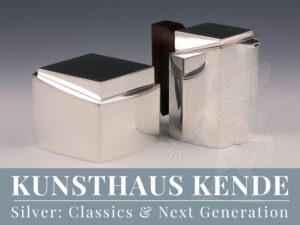Item number: 68330
A rare modernist 800 grade silver coffee and tea service
Milan circa 1960/70 made by Giuseppe Silva for Annicchiarico
The bodies standing on a smooth base, the walls of the bodies, square in cross-section, are subtly curved and terminated by a sloping, angular rim to the sides. The cube-shaped lid with straight edges protruding from the edge and finished by a even surface to the top. The spout of the coffeepot, teapot and milk jug runs the full length of the body at the front and ends in a flat, beak-shaped spout at the top. The silhouette-sawn handles of solid mahogany on the back.
Extremely rare in this form, both formally and in terms of practicality a coffee tea service conceived with great refinement, of high modernity and almost monumental quality. As a service worked in silver of additional rarity, as the use of steel for modern work was far more common in this period.
Teapot:
16.3 cm / 6.41″ tall to the lid; 683.2 g / 21.96 oz
Coffeepot:
22.3 cm / 8.77″ tall to the lid; 602.6 g / 19.37 oz
Milk jug:
8.3 cm / 3.26″ tall to the lid; 301.4 g / 9.69″
Sugar box:
9.0 cm / 3.54″ wide, 9.0 cm / 3.54″ deep, 6.9 cm / 2.71″ tall; 372.0 g / 11.96 oz
Total weight: 1959.2 g / 62.98 oz
Extremely rare in this form, both formally and in terms of practicality a coffee tea service conceived with great refinement. As a service worked in silver of additional rarity, as the use of steel for modern work was far more common in this period.
This silver coffee and tea service is undoubtedly a unique work, as can be seen above all from constructional details. The very refined design, composed purely of stereometric elements, also indicates that the coffee tea service is not only a unique piece, but also an artist’s design. The stylistic heaviness of the vessel forms is skilfully offset by the elongated, acute-angled handles. This service is also very unusual in terms of usability: to make cleaning easier, the handles of teapot, coffee pot and milk jug are removable as well as the lids. The handles have a continuous, v-shaped longitudinal notch, which is pushed onto a soldered profile on the backs of the jugs from below. An orthogonal transverse strip closes off the handles at the top and thus arrests them. Another unusual feature – and much more time-consuming to produce – is that the spout was not press-moulded in one piece from the front plate of the body, but formed separately and soldered on.
Another technically unusual solution can be seen in the pouring of the liquid: when pouring, the liquid enters under the folded upper rim and thus gets into the spout. When stopping pouring, the liquid flows down the inside of the spout and emerges from two holes in the lowest part of the spout at the inner side, just above the base, into the body.
When designing the handles, the narrow upper area was reinforced by hidden dowels and the front sides of the dowels were coated with veneer to ensure the overall visual impression won´t be disturbed. This is another detail that indicates it´s a custom-made piece. The hallmark inventory also indicates that the service was most likely not intended for the regular trade but was a commissioned work. Although the individual bodies are all stamped with the Milanese hallmark, the maker´s mark of Giuseppe Silva and the fineness “800”, the lids are not. However, an X-ray fluorescence analysis of all the individual parts showed that the service belongs together in its original form and was made of the same material. Although the lids were also made of 800 silver, they are not hallmarked. If the service had been intended for regular sale, hallmarking of the lids would have been obligatory.
Considering the stylistic and technical peculiarities of this 800 grade silver service, it is an object of great rarity.










